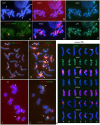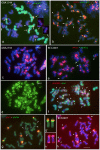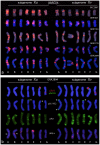Chromosomal characterization of the three subgenomes in the polyploids of Hordeum murinum L.: new insight into the evolution of this complex
- PMID: 24349062
- PMCID: PMC3862567
- DOI: 10.1371/journal.pone.0081385
Chromosomal characterization of the three subgenomes in the polyploids of Hordeum murinum L.: new insight into the evolution of this complex
Abstract
Hordeum murinum L. is a species complex composed of related taxa, including the subspecies glaucum, murinum and leporinum. However, the phylogenetic relationships between the different taxa and their cytotypes, and the origin of the polyploid forms, remain points of controversy. The present work reports a comparative karyotype analysis of seven accessions of the H. murinum complex representing all subspecies and cytotypes. The karyotypes were determined by examining the distribution of the repetitive Triticeae DNA sequences pTa71, pTa794, pSc119.2, pAs1 and pHch950, the simple sequence repeats (SSRs) (AG)10, (AAC)5, (AAG)5, (ACT)5, (ATC)5, and (CCCTAAA)3 via in situ hybridization. The chromosomes of the three subgenomes involved in the polyploids were identified. All tetraploids of all subspecies shared the same two subgenomes (thus suggesting them to in fact belong to the same taxon), the result of hybridization between two diploid ancestors. One of the subgenomes present in all tetraploids of all subspecies was found to be very similar (though not identical) to the chromosome complement of the diploid glaucum. The hexaploid form of leporinum came about through a cross between a tetraploid and a third diploid form. Exclusively bivalent associations among homologous chromosomes were observed when analyzing pollen mother cells of tetraploid taxa. In conclusion, the present results identify all the individual chromosomes within the H. murinum complex, reveal its genome structure and phylogeny, and explain the appearance of the different cytotypes. Three cryptic species are proposed according to ploidy level that may deserve full taxonomic recognition.
Conflict of interest statement
Figures






Similar articles
-
The evolutionary history of sea barley (Hordeum marinum) revealed by comparative physical mapping of repetitive DNA.Ann Bot. 2013 Dec;112(9):1845-55. doi: 10.1093/aob/mct245. Epub 2013 Nov 5. Ann Bot. 2013. PMID: 24197750 Free PMC article.
-
Diversity and evolution of the Hordeum murinum polyploid complex in Algeria.Genome. 2011 Aug;54(8):639-54. doi: 10.1139/g11-032. Epub 2011 Aug 17. Genome. 2011. PMID: 21848403
-
Physical mapping of repetitive DNA sequences and 5S and 18S-26S rDNA in five wild species of the genus Hordeum.Chromosome Res. 1996 Nov;4(7):491-9. doi: 10.1007/BF02261776. Chromosome Res. 1996. PMID: 8939360
-
Physical organisation of simple sequence repeats (SSRs) in Triticeae: structural, functional and evolutionary implications.Cytogenet Genome Res. 2008;120(3-4):210-9. doi: 10.1159/000121069. Epub 2008 May 22. Cytogenet Genome Res. 2008. PMID: 18504349 Review.
-
Genetic and genomic interactions of animals with different ploidy levels.Cytogenet Genome Res. 2013;140(2-4):117-36. doi: 10.1159/000351593. Epub 2013 Jun 8. Cytogenet Genome Res. 2013. PMID: 23751376 Review.
Cited by
-
Diversification of the P genome among Agropyron Gaertn. (Poaceae) species detected by FISH.Comp Cytogenet. 2017 Aug 3;11(3):495-509. doi: 10.3897/CompCytogen.v11i3.13124. eCollection 2017. Comp Cytogenet. 2017. PMID: 29093800 Free PMC article.
-
Interstitial Telomeric-like Repeats (ITR) in Seed Plants as Assessed by Molecular Cytogenetic Techniques: A Review.Plants (Basel). 2021 Nov 22;10(11):2541. doi: 10.3390/plants10112541. Plants (Basel). 2021. PMID: 34834904 Free PMC article. Review.
-
Molecular karyotyping of Siberian wild rye (Elymus sibiricus L.) with oligonucleotide fluorescence in situ hybridization (FISH) probes.PLoS One. 2020 Jan 17;15(1):e0227208. doi: 10.1371/journal.pone.0227208. eCollection 2020. PLoS One. 2020. PMID: 31951623 Free PMC article.
-
Developing New Oligo Probes to Distinguish Specific Chromosomal Segments and the A, B, D Genomes of Wheat (Triticum aestivum L.) Using ND-FISH.Front Plant Sci. 2018 Jul 26;9:1104. doi: 10.3389/fpls.2018.01104. eCollection 2018. Front Plant Sci. 2018. PMID: 30093909 Free PMC article.
-
Pipeline for the Rapid Development of Cytogenetic Markers Using Genomic Data of Related Species.Genes (Basel). 2019 Feb 1;10(2):113. doi: 10.3390/genes10020113. Genes (Basel). 2019. PMID: 30717300 Free PMC article.
References
-
- Van de Peer Y, Maere S, Meyer A (2009) The evolutionary significance of ancient genome duplications. Nat Rev Genet 10: 725–732. - PubMed
-
- Bothmer RV, Flink J, Landström T (1986) Meiosis in interspecific Hordeum hybrids. I. Diploid combinations. Can J Genet Cytol 28: 525–535.
-
- Bothmer RV, Flink J, Landström T (1987) Meiosis in interspecific Hordeum hybrids. II. Triploid combinations. Evol. Trends Plants 1: 41–50.
-
- Linde-Laursen I, Bothmer RV, Jacobsen N (1992) Relationships in the genus Hordeum: Giemsa C-banded karyotypes. Hereditas 116: 111–116.
-
- Wang RRC, Bothmer RV, Dvorak J, Fedak G, Linde-Laursen I, et al.. (1996) Genome symbols in the Triticeae In: Wang RRC, Jensen KB and Jaussi C (eds) Proceedings of the 2nd International Triticeae Symposium, Utah State University, Logan, pp 29–34
Publication types
MeSH terms
LinkOut - more resources
Full Text Sources
Other Literature Sources
Molecular Biology Databases
Research Materials

